Assassin’s Creed IV: Black Flag – Review
by Stu
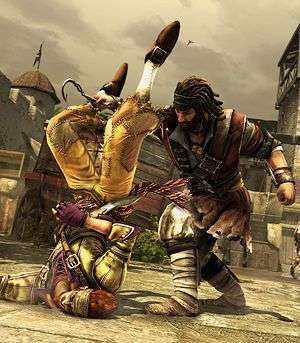 Assassin’s Creed IV: Black Flag is Ubisoft’s latest update in the saga of the ongoing battle between the hooded, stabby Assassins and the world-domination-obsessed Templar Order. Ubisoft was in a very interesting position, as Assassin’s Creed III had wrapped up the Desmond story arc and left their hands very much unbound – they could do anything they wished.
Assassin’s Creed IV: Black Flag is Ubisoft’s latest update in the saga of the ongoing battle between the hooded, stabby Assassins and the world-domination-obsessed Templar Order. Ubisoft was in a very interesting position, as Assassin’s Creed III had wrapped up the Desmond story arc and left their hands very much unbound – they could do anything they wished.
Black Flag follows the adventures of Edward Kenway, father to Haytham Kenway and grandfather to Ratonhnhaké:ton (Connor Kenway) who were both the focus of Assassin’s Creed III. Shifting focus from the American Revolution to the pirate-infested Caribbean was a shrewd move, allowing the political and historical overtones that bogged down AC3 to be lessened while still being threads that hold the game together. The NPC roster for Black Flag is a who’s who of pirate legends from ‘Blackbeard’ to Anne Bonny through to Bartholomew ‘Black Bart’ Roberts. Edward himself has a more brazen personality than his grandson and this does make for a more enjoyable character to play.
Once more the game consists of two stories, with one part occurring in modern times outside of the animus and the other, major, story inside the animus. With Desmond no longer the protagonist you assume the mantle of an unnamed person under the employ of Abstergo Entertainment, a subsidiary of the Abstergo Industries any Assassin’s Creed players will already be familiar with. As in previous games, the ‘out of animus’ experience reveals what the modern-day Templars are up to and this first-person viewpoint is punctuated by minigames, such as a frogger-styled hacking game where you need to get your ‘blip’ across a few columns of moving data. There is a wealth of information to be found and, as is traditional, the events that transpire raise more questions than they answer.
Inside the Animus, the story revolves around Edward and his mission to return to England (and his wife) as a rich man to both live a privileged life and to prove himself worthy in the eyes of his father-in-law. Unlike previous games there are no immediate family ties or pre-existing knowledge of the Templars or Assassins, thus providing a new angle to start the story from – although being able to pull off master assassin moves after just a couple of years privateering and no actual assassin training is something I struggled to look past. It’s a minor point though, and Ubisoft ultimately did a great job of intertwining real historical events into their fiction, albeit with a little skewing to add the inclusion of Edward. In fact it the intertwining is so subtle that I’d bet most players don’t even realise that they are involved in an adaption of real historical events. I’d even go as far as to say that this is the best storyline inside the animus since the original Assassin’s Creed; the balance between intrigue, plot progression and sheer enjoyment of the story was spot on, if a little slow to start off with.
 A sidestep away from the previous games comes in the massively expanded role that ships and naval combat play in the game. What was mostly a few side missions in AC3 is now a main part of the game, and listening to your crew sing their shanties while you glide across the sea will become a familiar pastime. Upgrading Kenway’s ship is as important, if not more, than the upgrades for Edward himself if you want to survive the rougher parts of the pirating world.
A sidestep away from the previous games comes in the massively expanded role that ships and naval combat play in the game. What was mostly a few side missions in AC3 is now a main part of the game, and listening to your crew sing their shanties while you glide across the sea will become a familiar pastime. Upgrading Kenway’s ship is as important, if not more, than the upgrades for Edward himself if you want to survive the rougher parts of the pirating world.
In terms of game mechanics such as combat, sneaking, and climbing there is nothing new. Literally no new tricks have been added to the game in that respect and, in fact, things such as the number of weapon variations have been reduced. At end game your entire arsenal will consist of a blowdart pipe (with two types of ammo), rope darts, pistols, smoke bombs, hidden blades, and cutlasses. Enemies will have the odd weapon you can take from them or pick up after they have been dispatched – the rifles (as with AC3) are particularly useful for long-range sniping.
Notoriety has also had a makeover with Black Flag; no longer are there posters or bribes to be made in towns if you get high notoriety with the guards. Instead it returns to the simpler ways of the original Assassin’s Creed – flee the area and hide until the guards stop looking for you and return to their duties. As with previous games in the series, the usual methods for hiding still exist – from hay bales through to following a crowd around, and you can still hire thugs and dancers to aid you in distracting the enemy.
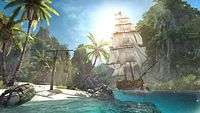 |
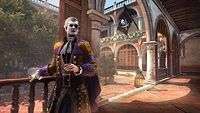 |
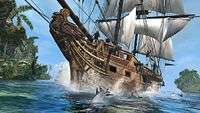 |
 |
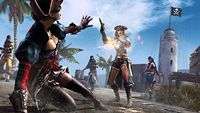 |
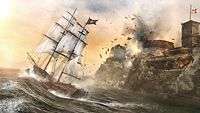 |
Another simplification comes from hunting, with a handful of land animals to be killed and skinned in order to upgrade equipment or sell for cash. Unlike Assassin’s Creed III, you do not have traps, bait, or even have to worry about the method of dispatch – there is no penalty for shooting animals dead (whereas in AC3 the pelt was classed as damaged) and they all die with one pistol shot. In addition to hunting on land is the slightly contentious whaling minigame where you hunt sharks and whales from a rowing boat using hand-thrown harpoons. Even with the fully upgraded harpoon, the creatures will need a few hits and Black Flag is not shy on gory detail, with blood pouring from them to pollute the surrounding water. When the hunt is over and the beast is pulled up by the main ship it’s a very sad sight and made me feel quite bad about killing them. For a game franchise that has had me killing people and animals for years, I wasn’t prepared for that surprise. Thankfully, if you decide that hunting and whaling are not to your taste then you can buy the ingredients from local vendors instead for a stupid amount of money.
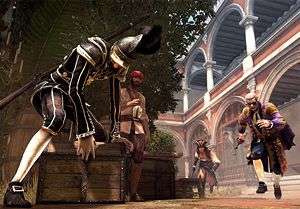 It wouldn’t be an Assassin’s Creed if there weren’t more collectibles than you can shake a stick at. This time you will be collecting treasure maps (for buried treasure), animus fragments (for a reason I am still unclear about), small treasure chests, manuscripts, Mayan stones, and shanties. As with the last few games, almost every collectible in the area is shown once you synchronise with the relevant high point on the map or, in the case of sea-based collectibles, when you destroy a fort and claim it for the pirates. The world map helpfully tints all location placeholders with a yellow colour if all activities and collectibles have been completed.
It wouldn’t be an Assassin’s Creed if there weren’t more collectibles than you can shake a stick at. This time you will be collecting treasure maps (for buried treasure), animus fragments (for a reason I am still unclear about), small treasure chests, manuscripts, Mayan stones, and shanties. As with the last few games, almost every collectible in the area is shown once you synchronise with the relevant high point on the map or, in the case of sea-based collectibles, when you destroy a fort and claim it for the pirates. The world map helpfully tints all location placeholders with a yellow colour if all activities and collectibles have been completed.
As should be the impression by now, the land-based part of Assassin’s Creed IV: Black Flag is slightly streamlined and very much more of the usual fare of sneak, stalk, stab, repeat. Where Ubisoft clearly spent most of their time was on the sea and making a larger world for you to frolic about in.
The seafaring Edward can go pretty much anywhere he pleases on the world map (although a few locations lay tied to main story progression). Whilst roaming the open sea, you can attack and plunder British or Spanish ships from small gunboats through to brigs and huge men-of-war. There are many collectibles on tiny islands, and the sea is also home to a few wrecks that can be explored once you obtain the diving bell upgrade for your ship. To reveal the world map and gain access to special naval missions (not too dissimilar to those in AC3) you can destroy the various forts lying around the Caribbean and, once destroyed, you have to dock and fight your way to the base commander to take control. After you own a fort you can fast travel to its location as you can any of the other major discovered locations.
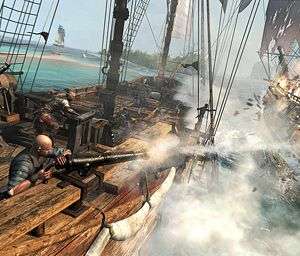 Ship combat has had a considerable upgrade, and your vessel carries multiple methods of attack. You can mortar from long range, broadside cannon with round or heavy shot, tear through sails with front-mounted chain-shot cannons, destroy chasing ships with explosive barrels, take out weak points with swivel cannons or just ram the enemy. The various attacks are based around where your camera is looking (side for cannons, front for chain shot, back for flaming barrels) or via button press for the others. The responsiveness of the ship depends on your level of sail (and the angle of the wind), which will be needed to avoid devastating mortar blows from attacking vessels, but care has been taken to ensure that you never feel totally helpless in a sea of calm water with more of an arcade style to ship control rather than a realistic feel.
Ship combat has had a considerable upgrade, and your vessel carries multiple methods of attack. You can mortar from long range, broadside cannon with round or heavy shot, tear through sails with front-mounted chain-shot cannons, destroy chasing ships with explosive barrels, take out weak points with swivel cannons or just ram the enemy. The various attacks are based around where your camera is looking (side for cannons, front for chain shot, back for flaming barrels) or via button press for the others. The responsiveness of the ship depends on your level of sail (and the angle of the wind), which will be needed to avoid devastating mortar blows from attacking vessels, but care has been taken to ensure that you never feel totally helpless in a sea of calm water with more of an arcade style to ship control rather than a realistic feel.
When attacking ships you can choose to incapacitate and then board or continue shooting until they sink. Boarding a ship requires that you kill a certain number of their crew and potentially perform other tasks such as tearing down their flag or blowing up powder kegs. Once met, the ship is yours and you can use it to reduce notoriety, repair your own ship, or send to your fleet. Edward’s fleet is a minigame played online via the Uplay passport (now free) and accessed from the cabin of your ship. The game is optional and can be a source of income by sending your fleet ships on trading runs or into battle to clear the trading routes of enemies. Most evenings the servers would drop regularly and either kick me from the minigame, or deny me access altogether. Behold the power of the cloud… sorry, next-gen isn’t quite here yet, is it? Nevertheless, it is a worrying thing when a minigame is always going offline and yet the future of gaming seems to be residing in the cloud.
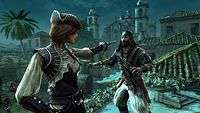 |
 |
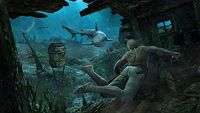 |
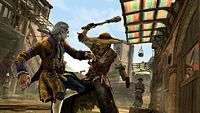 |
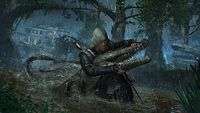 |
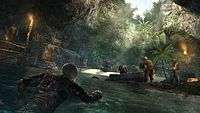 |
Notoriety when out to sea works on a scale system. Take down a couple of small ships and you’ll probably be fine; continue your actions and you will become wanted. For each additional ‘wanted’ level, the ships sent out to hunt you become more dangerous and often end up in pairs. There is no decay over time so you have to bribe an official at a port or capture ships and use them to reduce your wanted rating one level at a time. Ultimately, you will rarely be bothered by hunter ships unless you deliberately go out looking for trouble.
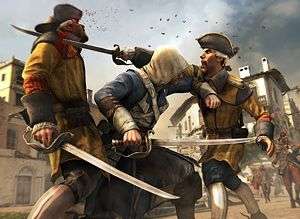 There is something extra in Black Flag that is pretty subtle, yet still noticeable – the predominantly plain white, almost surgically clean experience with the previous adventures in the animus and UI has been radically altered. The main menu and loading screens now have multiple colours, presumably to fit in line with the Abstergo Entertainment twist on things, but it does make it feel fresher. Much like the vibrant colour palette of the Caribbean, from lush green jungles and sandy beaches to pink and yellow paint on houses in Havana. Where sometimes previous games seemed to suffer from architectural copy and paste, there has been a noticeable drive to give each place its own identity and to vary the environments.
There is something extra in Black Flag that is pretty subtle, yet still noticeable – the predominantly plain white, almost surgically clean experience with the previous adventures in the animus and UI has been radically altered. The main menu and loading screens now have multiple colours, presumably to fit in line with the Abstergo Entertainment twist on things, but it does make it feel fresher. Much like the vibrant colour palette of the Caribbean, from lush green jungles and sandy beaches to pink and yellow paint on houses in Havana. Where sometimes previous games seemed to suffer from architectural copy and paste, there has been a noticeable drive to give each place its own identity and to vary the environments.
The enhanced weather system, particularly when out to sea and having to avoid rogue giant waves or cyclones (oft referred to as ‘water devils’ by your crew), adds to the feeling of a vibrant and changing world. You never get the same feeling of pointless and wasted space like you perhaps did in the frontier of AC3. Despite it’s bigger world, Black Flag seems to be have more content inside and the fast travel between synchronization points is a great inclusion.
Naturally, multiplayer makes a return and there have been additions with Black Flag. The Wolfpack mode, which debuted in AC3, comes back for some co-op challenges and a great set of introductory tutorial missions. The standard player-vs-player setup also exists with the usual roster of kill-or-be-killed modes but, in addition to the standard rules, there is a gamelab mode which allows players to create their own rulesets, I took part in a wanted match where only pistols were present and no melee takedowns were allowed.
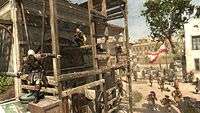 |
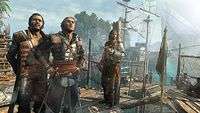 |
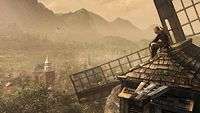 |
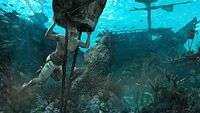 |
 |
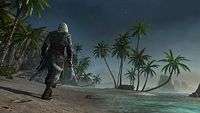 |
Players level up via experience gained in each match, unlocking new skills and traits and customising the skill sets as they go. Ubisoft also seem to have built in micro-transactions whereby you can buy points towards unlocking abilities and slots to store your preferred builds. While it certainly isn’t a requirement, it is fairly in-your-face and definitely, on first impressions at least, one of those nasty pay-to-win scenarios. I hate microtransactions and I wasn’t about to endorse the system with my own cash, so I presume that the items are not locked to a level, therefore you could effectively outfit a level one character with more skills than a traditional player would have access to, and I’m not sure how that impacts any matchmaking. Clearly, being a fully-loaded multiplayer character has an advantage over the other level one n00bs in your first couple of games. It’s always disappointing and unnecessary when a full retail game throws in a pay-to-win system that belongs on a 79p mobile app.
Pros- A great melding of historical fact with fiction
- Interesting characters and story both inside and outside of the animus
- Naval combat and free-roaming is executed with excellence
- Plenty of side distractions such as assassin missions, collectibles, hunting, Kenway’s Fleet, and more
- Graphically stunning and subtle UI/colour changes make the whole game feel fresh
- For all the great animation, you can win 99% of all Edward’s combat by relying on counters alone
- Multiplayer microtransactions are a terrible crime against this franchise
- Collectible overkill, especially around animus fragments that gave no rewards (unlike outfits or video snippets as per previous games)
- Limited enemy variety both on land and sea
Assassin’s Creed IV: Black Flag made me really sit up and take notice of the franchise once again. It is obvious from some elements that the yearly launch-cycle is taking its toll with similar enemies being plucked from AC3, boiled-down weapon choices, and the same types of mission making up the storyline (sneak, stalk, stab, repeat) but Ubisoft put the resources to where they were needed and made up for those shortfalls. The story, although slow to start, soon got going and the events outside of the animus had me asking questions just as I did at the end of the original Assassin’s Creed. Graphically, the game is impressive, very impressive, and not just through use of colour but differing locations, architecture and wildlife all combine to make an amazing experience. The character you play and those you meet are interesting and steeped in history that, once again, the writers weave through the unique fiction of this franchise. Plus the major selling point of the game, the ship combat and exploration, is brilliantly executed whilst not detracting from the traditional feel and aspects of an Assassin’s Creed game.
Ubisoft learned some hard lessons from Assassin’s Creed III and have gone a long way to restoring faith that the series still has legs and new adventures in store. There are still the odd niggles here and there, the repetitive nature of missions are made obvious at times, and the very limited types of enemy you face only exacerbates it further.
Overall though, I’ve not enjoyed an Assassin’s Creed this much since the original. Black Flag brought the perfect balance between old and new, which should help attract any new players or even those who grew tired of the repetitive releases or storyline. With its twists and turns in the story as well as solid action focus, anyone who is a fan of the franchise should put this on their shopping list.
Last five articles by Stu
- When A Choice Isn't Really A Choice At All
- Best of 2013: Next-Gen: #Fail
- Deadfall Adventures - Review
- Assassin's Creed IV: Black Flag - Review
- The Inner World - Review


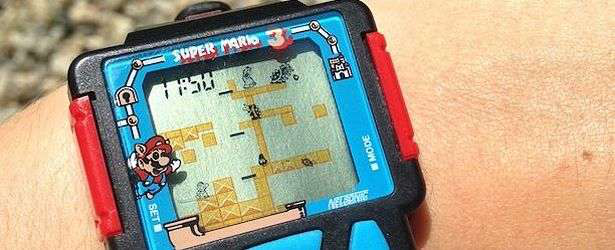














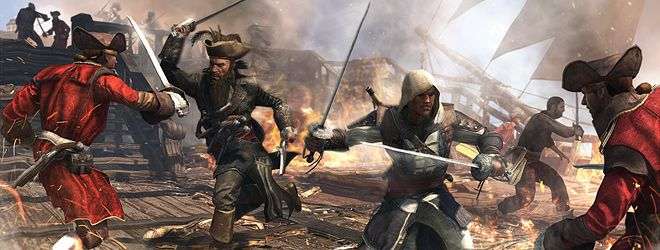
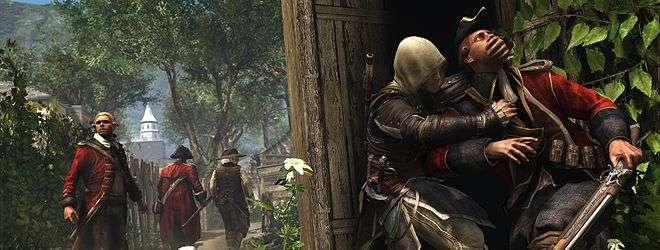
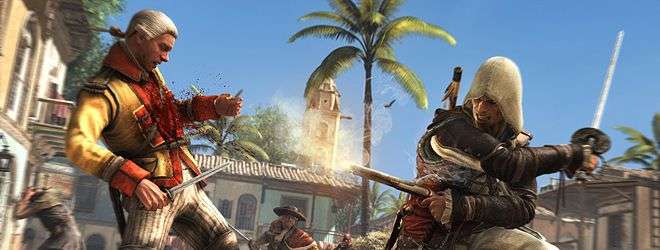






There are no comments, yet.
Why don’t you be the first? Come on, you know you want to!